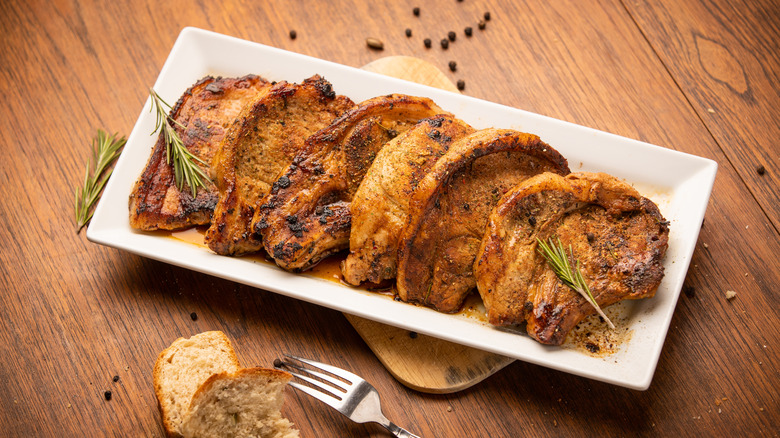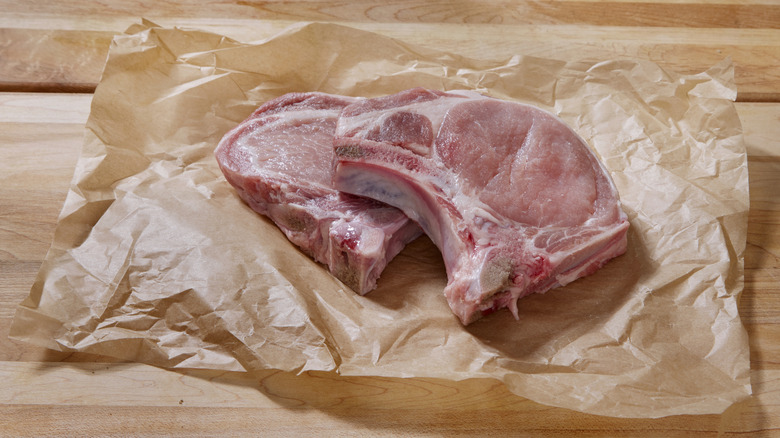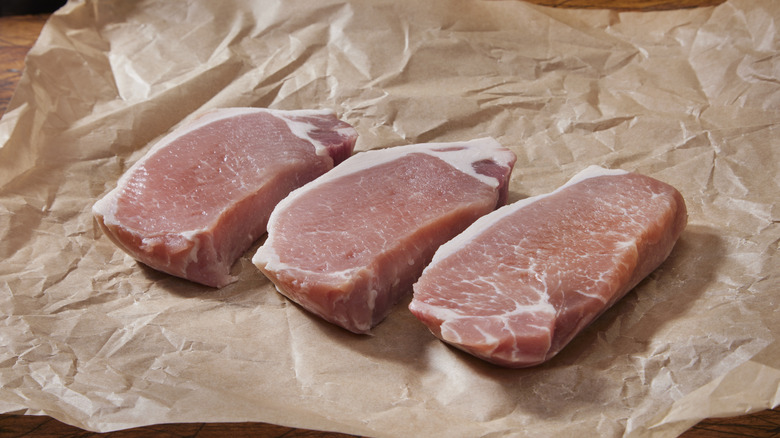Why Boneless Pork Chops Should Always Be Your Second Choice
Pork chops are America's quintessential cut of pig. Diverse takes like a jerk pork chop recipe prove that protein is a staple dinner offering in countless households. They can also be a source of frustration for the home cook, though. Pork chops tend to dry out and turn tough, leaving you with little in the way of flavor and a lot in the way of chewing. Unless you're chasing those jaw gains, tough meat doesn't belong anywhere near your plate. It's easier to prevent this than you might think. The biggest reason your pork chops turn out chewy might have nothing to do with how you're cooking them. It could be because you're buying boneless pork chops.
Boneless meat is understandably appealing as it makes cutting and serving the meat easier. That minor gain in convenience isn't worth it when you consider what purpose the bone plays in cooking. Bones are largely hollow inside, built in a honeycomb pattern with lots of tiny air pockets. Structurally, this is similar to many types of insulation used in buildings. Believe it or not, bones serve a similar purpose. The air within a bone insulates the meat it's attached to while it cooks. Bone-in meat cooks more slowly, which is a good thing because it makes it much harder to overcook. Furthermore, meat dries out when moisture escapes the muscle. Bones, however, reduce the surface area of muscle exposed to air. That can help keep your meat tender.
There are multiple types of bone-in pork chops
Pork chops come from a pig's loin, the long group of muscles that run along the animal's back from its shoulders to its hind legs. There are different types of bone-in pork chops. They are all differentiated by how they are cut from the larger loin. The most common type of pork chop is the rib chop, which is probably what you picture if you think of pork chops. It has a round medallion of light loin meat with a long, slightly curved rib bone attached to one side.
The second-most common type of pork chop is the center-cut chop. This cut has a T-shaped bone in the center and two different types of meat attached. On one side of the bone, you have the same light loin meat found on a rib chop. On the other side, you have an additional portion of tenderloin meat, which is darker and richer in flavor. It's essentially the T-bone steak of the pork world. Because it comes with extra meat attached, a center-cut chop is typically going to be more expensive than a rib chop.
Another type of bone-in pork chop that isn't as common as the rib and center-cut varieties is the blade chop. This chop includes some of the shoulder blade bone and is composed of multiple different muscles. Blade chops also have darker meat and more connective tissue which makes them better suited for braising.
What to do if you can only get boneless pork chops
It shouldn't be difficult to find bone-in pork chops at any butcher's counter. Just in case you end up in a situation where you can only find boneless pork chops, hope is not entirely lost. It's more challenging to cook a boneless pork chop without it drying out but there are a few things you can do to improve the odds of a good result. To master this technique, it's important to understand the difference between dry rubs and marinades. Marinades are typically a mixture of oil, seasonings, and an acidic ingredient such as citrus juice. That mixture will help to break down some of the tough muscle fibers before cooking. Marinades are also a great way to infuse your meat with a variety of different flavors.
You can also make tender pork chops with the aid of a brine. A brine is a saltwater solution that typically has sugar and other seasonings in it as well. Brining draws additional moisture into the meat, which is especially effective in lean cuts like pork chops. Brining will help to tenderize the meat and make it more juicy without imparting as strong of a flavor as a marinade. Brines are great when you want to emphasize the natural pork flavor. Marinades and brines also work great with bone-in pork chops even though they aren't strictly necessary.


